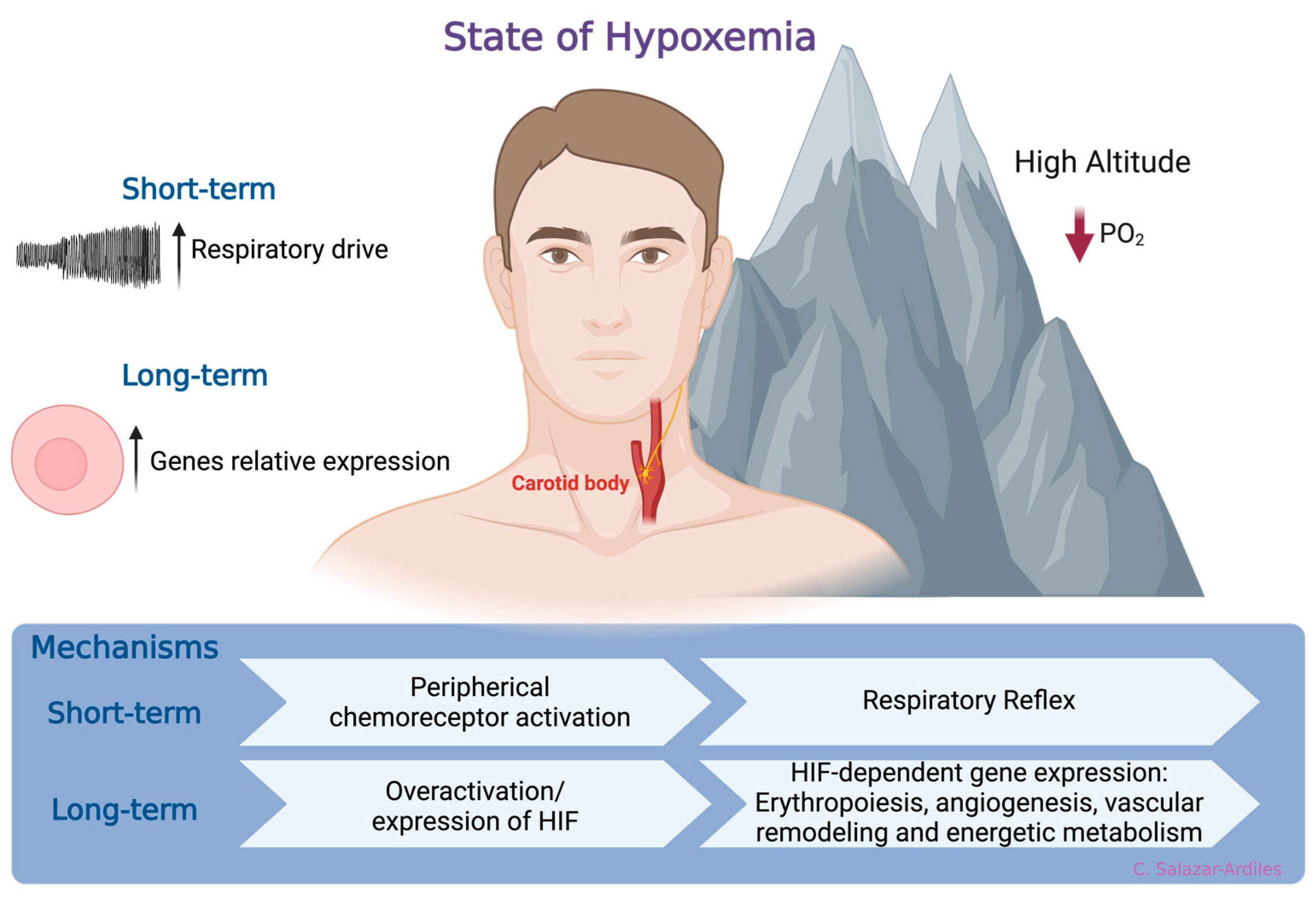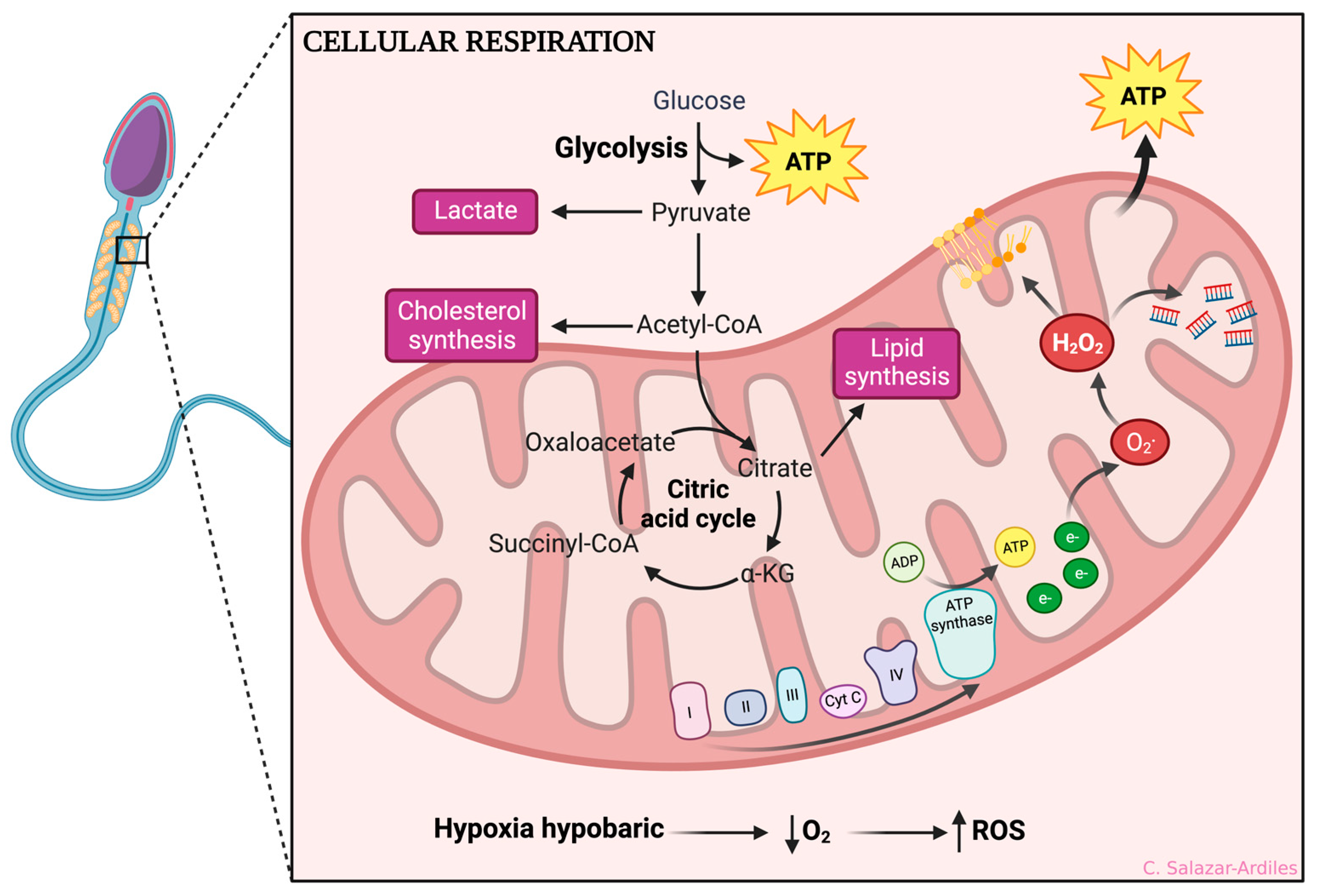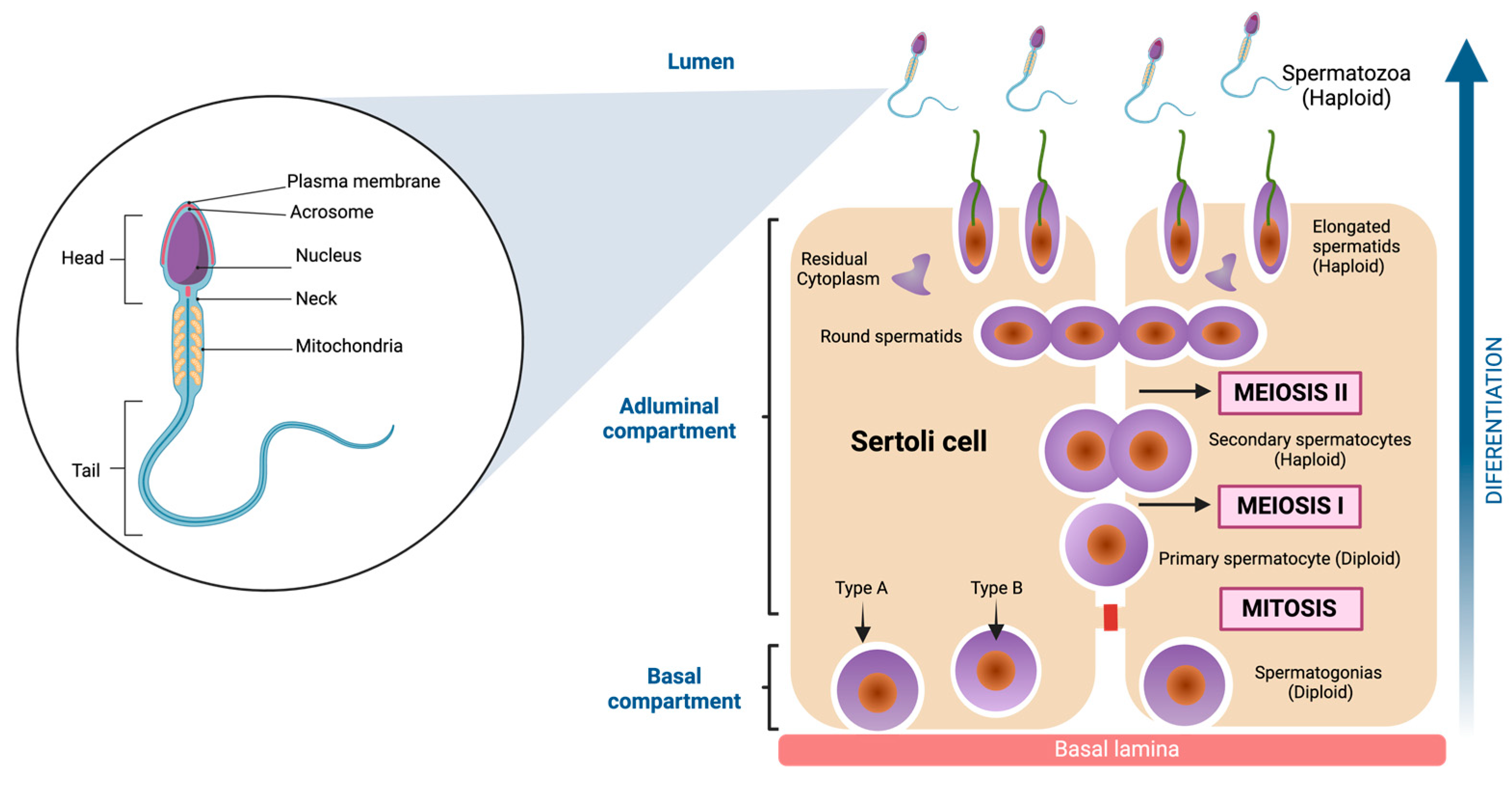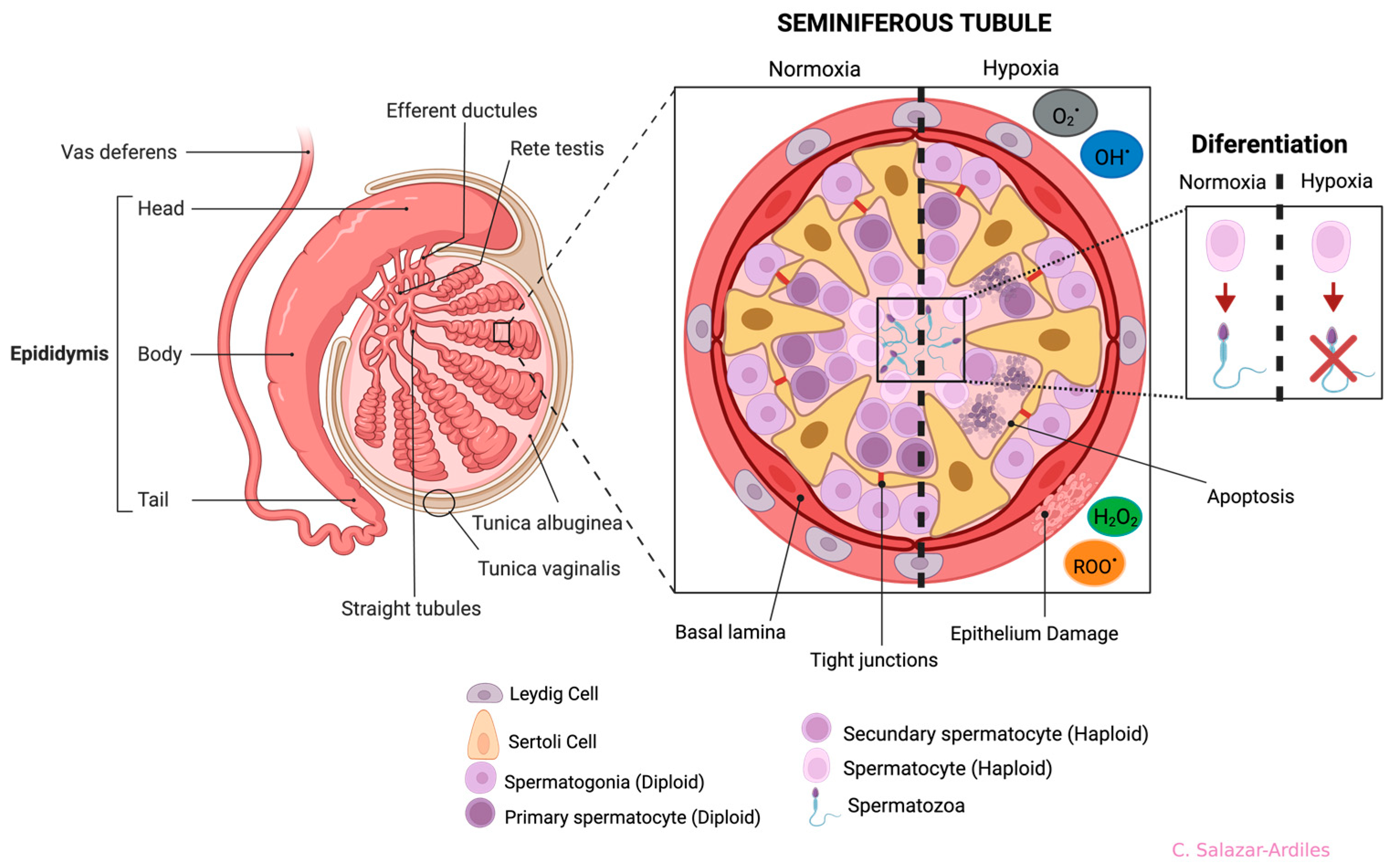Consequences of Exposure to Hypobaric Hypoxia Associated with High Altitude on Spermatogenesis and Seminal Parameters: A Literature Review
Abstract
:1. Introduction
2. Hypobaric Hypoxia
3. Oxidative Stress
4. Morphology of the Seminiferous Tubules
5. Hypoxia-Dependent Primary Structural Damage of the Seminiferous Tubules
6. Principal Damages Produced to Spermatogenesis by Hypoxia
7. Semen Parameters and Hypobaric Hypoxia
8. Conclusions
Author Contributions
Funding
Institutional Review Board Statement
Informed Consent Statement
Data Availability Statement
Conflicts of Interest
References
- Bhutta, B.S.; Alghoula, F.; Berim, I. Hypoxia. Disclosure: Faysal Alghoula declares no relevant financial relationships with ineligible companies. Disclosure: Ilya Berim declares no relevant financial relationships with ineligible companies. In StatPearls; Treasure Island (FL) Ineligible Companies: St. Petersburg, FL, USA, 2023. [Google Scholar]
- Luks, A.M. Physiology in Medicine: A physiologic approach to prevention and treatment of acute high-altitude illnesses. J. Appl. Physiol. 2015, 118, 509–519. [Google Scholar] [CrossRef]
- Brent, M.B. A review of the skeletal effects of exposure to high altitude and potential mechanisms for hypobaric hypoxia-induced bone loss. Bone 2022, 154, 116258. [Google Scholar] [CrossRef]
- Gonzales, G.F. Hemoglobina y testosterona: Importancia en la aclimatación y adaptación a la altura. Rev. Peru. De Med. Exp. Y Salud Publica 2011, 28, 92–100. [Google Scholar] [CrossRef] [PubMed]
- Santolaya, R.B.; Lahiri, S.; Alfaro, R.T.; Schoene, R.B. Respiratory adaptation in the highest inhabitants and highest Sherpa mountaineers. Respir. Physiol. 1989, 77, 253–262. [Google Scholar] [CrossRef]
- Edwards, L.M.; Murray, A.J.; Tyler, D.J.; Kemp, G.J.; Holloway, C.J.; Robbins, P.A.; Neubauer, S.; Levett, D.; Montgomery, H.E.; Grocott, M.P.; et al. The effect of high-altitude on human skeletal muscle energetics: P-MRS results from the Caudwell Xtreme Everest expedition. PLoS ONE 2010, 5, e10681. [Google Scholar] [CrossRef]
- Farias, J.G.; Jimenez, D.; Osorio, J.; Zepeda, A.B.; Figueroa, C.A.; Pulgar, V.M. Acclimatization to chronic intermittent hypoxia in mine workers: A challenge to mountain medicine in Chile. Biol. Res. 2013, 46, 59–67. [Google Scholar] [CrossRef]
- Villafuerte, F.C.; Simonson, T.S.; Bermudez, D.; Leon-Velarde, F. High-Altitude Erythrocytosis: Mechanisms of Adaptive and Maladaptive Responses. Physiology 2022, 37, 175–186. [Google Scholar] [CrossRef]
- Burtscher, M.; Millet, G.P.; Burtscher, J. Hypoxia conditioning for high-altitude pre-acclimatization. J. Sci. Sport Exerc. 2022, 4, 331–345. [Google Scholar] [CrossRef]
- Penaloza, D.; Arias-Stella, J. The heart and pulmonary circulation at high altitudes: Healthy highlanders and chronic mountain sickness: Healthy highlanders and chronic mountain sickness. Circulation 2007, 115, 1132–1146. [Google Scholar] [CrossRef]
- Santos-Martinez, L.E.; Gomez-Tejada, R.A.; Murillo-Jauregui, C.X.; Hoyos-Paladines, R.A.; Poyares-Jardim, C.V.; Orozco-Levi, M. Chronic exposure to altitude. Clinical characteristics and diagnosis. Arch. Cardiol. Mex. 2021, 91, 500–507. [Google Scholar] [CrossRef]
- Núñez, A.; Arenas, F.; Sánchez, R. From a geographical mountain to mountain geographies. A social geography analysis of the Chilean Andes. Rev. De Geogr. Alp. 2017, 105-4. [Google Scholar] [CrossRef]
- Riesner, M.; Simoes, M.; Carrizo, D.; Lacassin, R. Early exhumation of the Frontal Cordillera (Southern Central Andes) and implications for Andean mountain-building at ~33.5°S. Sci. Rep. 2019, 9, 7972. [Google Scholar] [CrossRef] [PubMed]
- Alcántara Zapata, D.E. Efecto de la Hipoxia Hipobárica Crónica Intermitente en Los Niveles de Antígeno Prostático Específico (PSA) de Mineros Chileno. Ph.D. Thesis, Universidad de Chile, Santiago, Chile, 2020. [Google Scholar]
- Minsal. Trabajo en Altura Geográfica en Chile. Available online: https://www.ispch.cl/sites/default/files/Nota_Tecnica_N_19_Trabajo_en_Altura_Geografica_en_Chile.pdf (accessed on 19 October 2023).
- Okumura, A.; Fuse, H.; Kawauchi, Y.; Mizuno, I.; Akashi, T. Changes in male reproductive function after high altitude mountaineering. High Alt. Med. Biol. 2003, 4, 349–353. [Google Scholar] [CrossRef]
- Pelliccione, F.; Verratti, V.; D’Angeli, A.; Micillo, A.; Doria, C.; Pezzella, A.; Iacutone, G.; Francavilla, F.; Di Giulio, C.; Francavilla, S. Physical exercise at high altitude is associated with a testicular dysfunction leading to reduced sperm concentration but healthy sperm quality. Fertil. Steril. 2011, 96, 28–33. [Google Scholar] [CrossRef] [PubMed]
- He, J.; Cui, J.; Wang, R.; Gao, L.; Gao, X.; Yang, L.; Zhang, Q.; Cao, J.; Yu, W. Exposure to hypoxia at high altitude (5380 m) for 1 year induces reversible effects on semen quality and serum reproductive hormone levels in young male adults. High Alt. Med. Biol. 2015, 16, 216–222. [Google Scholar] [CrossRef]
- Zheng, S.; Liu, Y.; Li, P.; Tian, H. Short-Term High-Altitude Exposure (3600 m) Alters the Type Distribution of Sperm Deformity. High Alt. Med. Biol. 2019, 20, 198–202. [Google Scholar] [CrossRef]
- Verratti, V.; Di Giulio, C.; D’Angeli, A.; Tafuri, A.; Francavilla, S.; Pelliccione, F. Sperm forward motility is negatively affected by short-term exposure to altitude hypoxia. Andrologia 2016, 48, 800–806. [Google Scholar] [CrossRef]
- Saxena, D.K. Effect of hypoxia by intermittent altitude exposure on semen characteristics and testicular morphology of male rhesus monkeys. Int. J. Biometeorol. 1995, 38, 137–140. [Google Scholar] [CrossRef]
- Grocott, M.; Montgomery, H.; Vercueil, A. High-altitude physiology and pathophysiology: Implications and relevance for intensive care medicine. Crit. Care 2007, 11, 203. [Google Scholar] [CrossRef]
- Peacock, A.J. ABC of oxygen: Oxygen at high altitude. BMJ 1998, 317, 1063–1066. [Google Scholar] [CrossRef]
- Iturriaga, R.; Alcayaga, J.; Chapleau, M.W.; Somers, V.K. Carotid body chemoreceptors: Physiology, pathology, and implications for health and disease. Physiol. Rev. 2021, 101, 1177–1235. [Google Scholar] [CrossRef]
- Heymans, J.; Heymans, C. Sur les modifications directes et sur la regulation reflexe de l’activite du centre respiratoire de la tête isoléemdu chien. Arch. Int. Pharmacodyn. 1927, 33, 273–370. [Google Scholar]
- Semenza, G.L. Hypoxia-inducible factors in physiology and medicine. Cell 2012, 148, 399–408. [Google Scholar] [CrossRef]
- Semenza, G.L.; Nejfelt, M.K.; Chi, S.M.; Antonarakis, S.E. Hypoxia-inducible nuclear factors bind to an enhancer element located 3′ to the human erythropoietin gene. Proc. Natl. Acad. Sci. USA 1991, 88, 5680–5684. [Google Scholar] [CrossRef] [PubMed]
- Maxwell, P.H.; Wiesener, M.S.; Chang, G.W.; Clifford, S.C.; Vaux, E.C.; Cockman, M.E.; Wykoff, C.C.; Pugh, C.W.; Maher, E.R.; Ratcliffe, P.J. The tumour suppressor protein VHL targets hypoxia-inducible factors for oxygen-dependent proteolysis. Nature 1999, 399, 271–275. [Google Scholar] [CrossRef] [PubMed]
- Ivan, M.; Kondo, K.; Yang, H.; Kim, W.; Valiando, J.; Ohh, M.; Salic, A.; Asara, J.M.; Lane, W.S.; Kaelin, W.G., Jr. HIFalpha targeted for VHL-mediated destruction by proline hydroxylation: Implications for O2 sensing. Science 2001, 292, 464–468. [Google Scholar] [CrossRef] [PubMed]
- Murray, A.J.; Montgomery, H.E.; Feelisch, M.; Grocott, M.P.W.; Martin, D.S. Metabolic adjustment to high-altitude hypoxia: From genetic signals to physiological implications. Biochem. Soc. Trans. 2018, 46, 599–607. [Google Scholar] [CrossRef]
- Bisht, S.; Faiq, M.; Tolahunase, M.; Dada, R. Oxidative stress and male infertility. Nat. Rev. Urol. 2017, 14, 470–485. [Google Scholar] [CrossRef]
- Shaw, S.; Ghosh, D.; Kumar, U.; Panjwani, U.; Kumar, B. Impact of high altitude on key determinants of female reproductive health: A review. Int. J. Biometeorol. 2018, 62, 2045–2055. [Google Scholar] [CrossRef]
- Kudryavtseva, A.V.; Krasnov, G.S.; Dmitriev, A.A.; Alekseev, B.Y.; Kardymon, O.L.; Sadritdinova, A.F.; Fedorova, M.S.; Pokrovsky, A.V.; Melnikova, N.V.; Kaprin, A.D.; et al. Mitochondrial dysfunction and oxidative stress in aging and cancer. Oncotarget 2016, 7, 44879–44905. [Google Scholar] [CrossRef]
- Zhang, X.; Wu, X.; Hu, Q.; Wu, J.; Wang, G.; Hong, Z.; Ren, J.; Lab, T.; Surgical, I. Mitochondrial DNA in liver inflammation and oxidative stress. Life Sci. 2019, 236, 116464. [Google Scholar] [CrossRef] [PubMed]
- Du Plessis, S.S.; Agarwal, A.; Halabi, J.; Tvrda, E. Contemporary evidence on the physiological role of reactive oxygen species in human sperm function. J. Assist. Reprod. Genet. 2015, 32, 509–520. [Google Scholar] [CrossRef] [PubMed]
- Apel, K.; Hirt, H. Reactive oxygen species: Metabolism, oxidative stress, and signal transduction. Annu. Rev. Plant Biol. 2004, 55, 373–399. [Google Scholar] [CrossRef] [PubMed]
- Schieber, M.; Chandel, N.S. ROS function in redox signaling and oxidative stress. Curr. Biol. 2014, 24, R453–R462. [Google Scholar] [CrossRef] [PubMed]
- Peoples, J.N.; Saraf, A.; Ghazal, N.; Pham, T.T.; Kwong, J.Q. Mitochondrial dysfunction and oxidative stress in heart disease. Exp. Mol. Med. 2019, 51, 1–13. [Google Scholar] [CrossRef]
- Zhao, Y.; Chen, X.; Li, H.; Zhu, C.; Li, Y.; Liu, Y. Mitochondrial genome mutations in 13 subunits of respiratory chain complexes in Chinese Han and Mongolian hypertensive individuals. Mitochondrial DNA A DNA Mapp. Seq. Anal. 2018, 29, 1090–1099. [Google Scholar] [CrossRef]
- Sousa, J.S.; D’Imprima, E.; Vonck, J. Mitochondrial Respiratory Chain Complexes. Subcell Biochem. 2018, 87, 167–227. [Google Scholar] [CrossRef]
- Nolfi-Donegan, D.; Braganza, A.; Shiva, S. Mitochondrial electron transport chain: Oxidative phosphorylation, oxidant production, and methods of measurement. Redox Biol. 2020, 37, 101674. [Google Scholar] [CrossRef]
- Ho, Y.S.; Ma, H.Y.; Chang, H.Y.; Wei, B.L.; Lee, C.C.; Ho, S.Y.; Guo, H.R.; Wu, T.P.; Chang, W.H.; Wang, Y.J. Lipid peroxidation and cell death mechanisms in rats and human cells induced by chloral hydrate. Food Chem. Toxicol. 2003, 41, 621–629. [Google Scholar] [CrossRef]
- Tabner, B.J.; El-Agnaf, O.M.; German, M.J.; Fullwood, N.J.; Allsop, D. Protein aggregation, metals and oxidative stress in neurodegenerative diseases. Biochem. Soc. Trans. 2005, 33, 1082–1086. [Google Scholar] [CrossRef]
- Cooke, M.S.; Evans, M.D.; Dizdaroglu, M.; Lunec, J. Oxidative DNA damage: Mechanisms, mutation, and disease. FASEB J. 2003, 17, 1195–1214. [Google Scholar] [CrossRef] [PubMed]
- Higuchi, Y. Chromosomal DNA fragmentation in apoptosis and necrosis induced by oxidative stress. Biochem. Pharmacol. 2003, 66, 1527–1535. [Google Scholar] [CrossRef]
- Wood, G.J.A.; Cardoso, J.P.G.; Paluello, D.V.; Nunes, T.F.; Cocuzza, M. Varicocele-Associated Infertility and the Role of Oxidative Stress on Sperm DNA Fragmentation. Front. Reprod. Health 2021, 3, 695992. [Google Scholar] [CrossRef]
- Nakata, H.; Sonomura, T.; Iseki, S. Three-dimensional analysis of seminiferous tubules and spermatogenic waves in mice. Reproduction 2017, 154, 569–579. [Google Scholar] [CrossRef] [PubMed]
- Nakata, H. Morphology of mouse seminiferous tubules. Anat. Sci. Int. 2019, 94, 1–10. [Google Scholar] [CrossRef] [PubMed]
- Hess, R.A.; Hermo, L. Rete testis: Structure, cell biology and site for stem cell transplantation. In Encyclopedia of Reproduction; Elsevier: Amsterdam, The Netherlands, 2018; pp. 263–269. [Google Scholar]
- Neto, F.T.; Bach, P.V.; Najari, B.B.; Li, P.S.; Goldstein, M. Spermatogenesis in humans and its affecting factors. Semin. Cell Dev. Biol. 2016, 59, 10–26. [Google Scholar] [CrossRef] [PubMed]
- Zomer, H.D.; Reddi, P.P. Characterization of rodent Sertoli cell primary cultures. Mol. Reprod. Dev. 2020, 87, 857–870. [Google Scholar] [CrossRef]
- Gondos, B.; Zemjanis, R. Fine structure of spermatogonia and intercellular bridges in Macaca nemestrina. J. Morphol. 1970, 131, 431–446. [Google Scholar] [CrossRef]
- Reis, A.B.; Reis, F.M.; Salles, P.G.; Almeida, F.; Martello, R.; Assis, W.A.; Caldeira-Brant, A.L.; Tatsuo, E.S.; Chiarini-Garcia, H. A fertility-oriented method for histological processing of testicular biopsies in men with azoospermia. Syst. Biol. Reprod. Med. 2021, 67, 314–321. [Google Scholar] [CrossRef]
- Nakanishi, Y.; Shiratsuchi, A. Phagocytic removal of apoptotic spermatogenic cells by Sertoli cells: Mechanisms and consequences. Biol. Pharm. Bull. 2004, 27, 13–16. [Google Scholar] [CrossRef]
- Hugon, J.; Borgers, M. Ultrastructural and cytochemical changes in spermatogonia and Sertoli cells of whole-body irradiated mice. Anat. Rec. 1966, 155, 15–31. [Google Scholar] [CrossRef]
- Nistal, M.; Paniagua, R.; Esponda, P. Development of the endoplasmic reticulum during human spermatogenesis. Acta Anat. 1980, 108, 238–249. [Google Scholar] [CrossRef] [PubMed]
- Richer, G.; Baert, Y.; Goossens, E. In-vitro spermatogenesis through testis modelling: Toward the generation of testicular organoids. Andrology 2020, 8, 879–891. [Google Scholar] [CrossRef] [PubMed]
- Zirkin, B.R.; Goldberg, E. Spermatids. In Encyclopedia of Reproduction; Skinner, M.K., Ed.; Elsevier: Amsterdam, The Netherlands, 2018; pp. 42–46. [Google Scholar]
- Chen, H.; Mruk, D.D.; Lui, W.Y.; Wong, C.K.C.; Lee, W.M.; Cheng, C.Y. Cell polarity and planar cell polarity (PCP) in spermatogenesis. Semin. Cell Dev. Biol. 2018, 81, 71–77. [Google Scholar] [CrossRef] [PubMed]
- Troian, B.; Boscolo, R.; Ricci, G.; Lazzarino, M.; Zito, G.; Prato, S.; Andolfi, L. Ultra-structural analysis of human spermatozoa by aperture scanning near-field optical microscopy. J. Biophotonics 2020, 13, e2418. [Google Scholar] [CrossRef] [PubMed]
- Barroso, G.; Valdespin, C.; Vega, E.; Kershenovich, R.; Avila, R.; Avendano, C.; Oehninger, S. Developmental sperm contributions: Fertilization and beyond. Fertil. Steril. 2009, 92, 835–848. [Google Scholar] [CrossRef]
- Cikutovic, M.; Fuentes, N.; Bustos-Obregon, E. Effect of intermittent hypoxia on the reproduction of rats exposed to high altitude in the Chilean Altiplano. High Alt. Med. Biol. 2009, 10, 357–363. [Google Scholar] [CrossRef]
- Wang, J.; Gong, X.; Meng, F.; Deng, S.; Dai, H.; Bao, B.; Feng, J.; Li, H.; Wang, B. Biological Network Model of Effect of Chronic Intermittent Hypoxia on Spermatogenesis in Rats. Med. Sci. Monit. 2020, 26, e925579. [Google Scholar] [CrossRef]
- Vargas, A.; Bustos-Obregon, E.; Hartley, R. Effects of hypoxia on epididymal sperm parameters and protective role of ibuprofen and melatonin. Biol. Res. 2011, 44, 161–167. [Google Scholar] [CrossRef]
- Monge, C.; Chavéz-Mori, P. Fisiología de la reproducción en la altura-La espermatogénesis en la altura. An. De La Fac. De Med. 1942, 25, 34–40. [Google Scholar] [CrossRef]
- Farias, J.G.; Bustos-Obregon, E.; Orellana, R.; Bucarey, J.L.; Quiroz, E.; Reyes, J.G. Effects of chronic hypobaric hypoxia on testis histology and round spermatid oxidative metabolism. Andrologia 2005, 37, 47–52. [Google Scholar] [CrossRef] [PubMed]
- Liao, W.; Cai, M.; Chen, J.; Huang, J.; Liu, F.; Jiang, C.; Gao, Y. Hypobaric hypoxia causes deleterious effects on spermatogenesis in rats. Reproduction 2010, 139, 1031–1038. [Google Scholar] [CrossRef] [PubMed]
- He, T.; Guo, H.; Shen, X.; Wu, X.; Xia, L.; Jiang, X.; Xu, Y.; Chen, D.; Zhang, Y.; Tan, D.; et al. Hypoxia-induced alteration of RNA modifications in the mouse testis and spermdagger. Biol. Reprod. 2021, 105, 1171–1178. [Google Scholar] [CrossRef] [PubMed]
- Li, S.; Yang, Q.E. Hypobaric hypoxia exposure alters transcriptome in mouse testis and impairs spermatogenesis in offspring. Gene 2022, 823, 146390. [Google Scholar] [CrossRef]
- Jankovic Velickovic, L.; Stefanovic, V. Hypoxia and spermatogenesis. Int. Urol. Nephrol. 2014, 46, 887–894. [Google Scholar] [CrossRef]
- Bai, G.; Yang, B.; Tong, W.; Li, H. Hypobaric hypoxia causes impairment of spermatogenesis in developing rats at pre-puberty. Andrologia 2018, 50, e13000. [Google Scholar] [CrossRef] [PubMed]
- Griswold, M.D. Spermatogenesis: The Commitment to Meiosis. Physiol. Rev. 2016, 96, 1–17. [Google Scholar] [CrossRef]
- Sharma, S.; Hanukoglu, A.; Hanukoglu, I. Localization of epithelial sodium channel (ENaC) and CFTR in the germinal epithelium of the testis, Sertoli cells, and spermatozoa. J. Mol. Histol. 2018, 49, 195–208. [Google Scholar] [CrossRef]
- Yoshida, S. From cyst to tubule: Innovations in vertebrate spermatogenesis. Wiley Interdiscip Rev. Dev. Biol. 2016, 5, 119–131. [Google Scholar] [CrossRef]
- Waheeb, R.; Hofmann, M.C. Human spermatogonial stem cells: A possible origin for spermatocytic seminoma. Int. J. Androl. 2011, 34, e296–e305, discussion e305. [Google Scholar] [CrossRef]
- Ibtisham, F.; Wu, J.; Xiao, M.; An, L.; Banker, Z.; Nawab, A.; Zhao, Y.; Li, G. Progress and future prospect of in vitro spermatogenesis. Oncotarget 2017, 8, 66709–66727. [Google Scholar] [CrossRef] [PubMed]
- Ewen, K.A.; Koopman, P. Mouse germ cell development: From specification to sex determination. Mol. Cell Endocrinol. 2010, 323, 76–93. [Google Scholar] [CrossRef] [PubMed]
- Wenger, R.H.; Katschinski, D.M. The hypoxic testis and post-meiotic expression of PAS domain proteins. Semin. Cell Dev. Biol. 2005, 16, 547–553. [Google Scholar] [CrossRef] [PubMed]
- Liu, X.; Liu, S.; Xu, C. Effects of leptin on HPG axis and reproductive function in male rat in simulated altitude of 5500 m hypoxia environment. Biochem. Biophys. Res. Commun. 2020, 529, 104–111. [Google Scholar] [CrossRef] [PubMed]
- Kostereva, N.; Hofmann, M.C. Regulation of the spermatogonial stem cell niche. Reprod. Domest. Anim. 2008, 43 (Suppl. S2), 386–392. [Google Scholar] [CrossRef]
- Ventela, S.; Makela, J.A.; Kulmala, J.; Westermarck, J.; Toppari, J. Identification and regulation of a stage-specific stem cell niche enriched by Nanog-positive spermatogonial stem cells in the mouse testis. Stem. Cells 2012, 30, 1008–1020. [Google Scholar] [CrossRef]
- Voigt, A.L.; Thiageswaran, S.; de Lima, E.M.L.N.; Dobrinski, I. Metabolic Requirements for Spermatogonial Stem Cell Establishment and Maintenance In Vivo and In Vitro. Int. J. Mol. Sci. 2021, 22, 1998. [Google Scholar] [CrossRef]
- Ivanovic, Z. Hypoxia or in situ normoxia: The stem cell paradigm. J. Cell Physiol. 2009, 219, 271–275. [Google Scholar] [CrossRef]
- Chen, W.; Zhang, Z.; Chang, C.; Yang, Z.; Wang, P.; Fu, H.; Wei, X.; Chen, E.; Tan, S.; Huang, W.; et al. A bioenergetic shift is required for spermatogonial differentiation. Cell Discov. 2020, 6, 56. [Google Scholar] [CrossRef]
- Gonzales, G.F.; Gasco, M.; Córdova, A.; Chung, A.; Rubio, J.; Villegas, L. Effect of Lepidium meyenii (Maca) on spermatogenesis in male rats acutely exposed to high altitude (4340 m). J. Endocrinol. 2004, 180, 87–95. [Google Scholar] [CrossRef]
- Farias, J.G.; Puebla, M.; Acevedo, A.; Tapia, P.J.; Gutierrez, E.; Zepeda, A.; Calaf, G.; Juantok, C.; Reyes, J.G. Oxidative stress in rat testis and epididymis under intermittent hypobaric hypoxia: Protective role of ascorbate supplementation. J. Androl. 2010, 31, 314–321. [Google Scholar] [CrossRef] [PubMed]
- Farias, J.G.; Bustos-Obregon, E.; Reyes, J.G. Increase in testicular temperature and vascularization induced by hypobaric hypoxia in rats. J. Androl. 2005, 26, 693–697. [Google Scholar] [CrossRef] [PubMed]
- Terrizzi, A.R.; Martinez, M.P.; Fernandez-Solari, J. Altered production of reproductive neuropeptides in rats subjected to chronic intermittent hypoxia. J. Integr. Neurosci. 2021, 20, 651–657. [Google Scholar] [CrossRef] [PubMed]
- Narula, A. Variability in sperm suppression during testosterone administration to adult monkeys is related to follicle stimulating hormone suppression and not to intratesticular androgens. J. Clin. Endocrinol. Metab. 2002, 87, 3399–3406. [Google Scholar] [CrossRef] [PubMed]
- Farias, J.G.; Bustos-Obregon, E.; Tapia, P.J.; Gutierrez, E.; Zepeda, A.; Juantok, C.; Cruz, G.; Soto, G.; Benites, J.; Reyes, J.G. Time course of endocrine changes in the hypophysis-gonad axis induced by hypobaric hypoxia in male rats. J. Reprod. Dev. 2008, 54, 18–21. [Google Scholar] [CrossRef]
- Cho, Y.M.; Chou, J.C.; Fang, C.M.; Hu, S.; Wang, K.L.; Wang, S.W.; Wang, P.S. Chronic intermittent hypoxia stimulates testosterone production in rat Leydig cells. Life Sci. 2019, 233, 116694. [Google Scholar] [CrossRef]
- Boe-Hansen, G.B.; Ersboll, A.K.; Christensen, P. Variability and laboratory factors affecting the sperm chromatin structure assay in human semen. J. Androl. 2005, 26, 360–368. [Google Scholar] [CrossRef]
- Chaikuad, A.; Shafqat, N.; Al-Mokhtar, R.; Cameron, G.; Clarke, A.R.; Brady, R.L.; Oppermann, U.; Frayne, J.; Yue, W.W. Structure and kinetic characterization of human sperm-specific glyceraldehyde-3-phosphate dehydrogenase, GAPDS. Biochem. J. 2011, 435, 401–409. [Google Scholar] [CrossRef]
- Gao, J.; Yuan, R.; Yang, S.; Wang, Y.; Huang, Y.; Yan, L.; Jiang, H.; Qiao, J. Age-related changes in human conventional semen parameters and sperm chromatin structure assay-defined sperm DNA/chromatin integrity. Reprod. Biomed. Online 2021, 42, 973–982. [Google Scholar] [CrossRef]
- World Health Organization. WHO Laboratory Manual for the Examination and Processing of Human Semen. Available online: https://www.who.int/publications/i/item/9789240030787 (accessed on 12 November 2023).
- Aitken, R.J. Reactive oxygen species as mediators of sperm capacitation and pathological damage. Mol. Reprod. Dev. 2017, 84, 1039–1052. [Google Scholar] [CrossRef]
- Reyes, J.G.; Farias, J.G.; Henriquez-Olavarrieta, S.; Madrid, E.; Parraga, M.; Zepeda, A.B.; Moreno, R.D. The hypoxic testicle: Physiology and pathophysiology. Oxid. Med. Cell Longev. 2012, 2012, 929285. [Google Scholar] [CrossRef]
- Oger, I.; Da Cruz, C.; Panteix, G.; Menezo, Y. Evaluating human sperm DNA integrity: Relationship between 8-hydroxydeoxyguanosine quantification and the sperm chromatin structure assay. Zygote 2003, 11, 367–371. [Google Scholar] [CrossRef] [PubMed]
- Shiraishi, K.; Naito, K. Effects of 4-hydroxy-2-nonenal, a marker of oxidative stress, on spermatogenesis and expression of p53 protein in male infertility. J. Urol. 2007, 178, 1012–1017, discussion 1017. [Google Scholar] [CrossRef] [PubMed]
- Cicek, O.S.Y.; Kaya, G.; Alyuruk, B.; Doger, E.; Girisen, T.; Filiz, S. The association of seminal oxidation reduction potential with sperm parameters in patients with unexplained and male factor infertility. Int. Braz. J. Urol. 2021, 47, 112–119. [Google Scholar] [CrossRef] [PubMed]
- De Iuliis, G.N.; Thomson, L.K.; Mitchell, L.A.; Finnie, J.M.; Koppers, A.J.; Hedges, A.; Nixon, B.; Aitken, R.J. DNA damage in human spermatozoa is highly correlated with the efficiency of chromatin remodeling and the formation of 8-hydroxy-2’-deoxyguanosine, a marker of oxidative stress. Biol. Reprod. 2009, 81, 517–524. [Google Scholar] [CrossRef]
- Hosen, M.B.; Islam, M.R.; Begum, F.; Kabir, Y.; Howlader, M.Z. Oxidative stress induced sperm DNA damage, a possible reason for male infertility. Iran. J. Reprod. Med. 2015, 13, 525–532. [Google Scholar]
- Guz, J.; Gackowski, D.; Foksinski, M.; Rozalski, R.; Zarakowska, E.; Siomek, A.; Szpila, A.; Kotzbach, M.; Kotzbach, R.; Olinski, R. Comparison of oxidative stress/DNA damage in semen and blood of fertile and infertile men. PLoS ONE 2013, 8, e68490. [Google Scholar] [CrossRef]
- Kucharski, R.; Maleszka, J.; Foret, S.; Maleszka, R. Nutritional control of reproductive status in honeybees via DNA methylation. Science 2008, 319, 1827–1830. [Google Scholar] [CrossRef]
- Angulo, C.; Maldonado, R.; Pulgar, E.; Mancilla, H.; Cordova, A.; Villarroel, F.; Castro, M.A.; Concha, I.I. Vitamin C and oxidative stress in the seminiferous epithelium. Biol. Res. 2011, 44, 169–180. [Google Scholar] [CrossRef]
- Nowicka-Bauer, K.; Lepczynski, A.O.M.; Kamieniczna, M.; Fraczek, M.; Stanski, L.; Olszewska, M.; Malcher, A.; Skrzypczak, W.; Kurpisz, M.K. Sperm mitochondrial dysfunction and oxidative stress as possible reasons for isolated asthenozoospermia. J. Physiol. Pharmacol. Off. J. Pol. Physiol. Soc. 2018, 69, 403–417. [Google Scholar] [CrossRef]
- Luo, Y.; Liao, W.; Chen, Y.; Cui, J.; Liu, F.; Jiang, C.; Gao, W.; Gao, Y. Altitude can alter the mtDNA copy number and nDNA integrity in sperm. J. Assist. Reprod. Genet. 2011, 28, 951–956. [Google Scholar] [CrossRef] [PubMed]
- Kurkowska, W.; Bogacz, A.; Janiszewska, M.; Gabryś, E.; Tiszler, M.; Bellanti, F.; Kasperczyk, S.; Machoń-Grecka, A.; Dobrakowski, M.; Kasperczyk, A. Oxidative stress is associated with reduced sperm motility in normal semen. Am. J. Men’s Health 2020, 15, 1557988320939731. [Google Scholar] [CrossRef] [PubMed]
- Fedorova, M.; Bollineni, R.C.; Hoffmann, R. Protein carbonylation as a major hallmark of oxidative damage: Update of analytical strategies: Protein Carbonylation: An Analytical Update. Mass Spectrom. Rev. 2014, 33, 79–97. [Google Scholar] [CrossRef] [PubMed]
- Sohal, R.S. Role of oxidative stress and protein oxidation in the aging process. Free Radic. Biol. Med. 2002, 33, 37–44. [Google Scholar] [CrossRef] [PubMed]




Disclaimer/Publisher’s Note: The statements, opinions and data contained in all publications are solely those of the individual author(s) and contributor(s) and not of MDPI and/or the editor(s). MDPI and/or the editor(s) disclaim responsibility for any injury to people or property resulting from any ideas, methods, instructions or products referred to in the content. |
© 2024 by the authors. Licensee MDPI, Basel, Switzerland. This article is an open access article distributed under the terms and conditions of the Creative Commons Attribution (CC BY) license (https://creativecommons.org/licenses/by/4.0/).
Share and Cite
Cornejo-Guerra, C.; Salazar-Ardiles, C.; Morales, P.; Andrade, D.C. Consequences of Exposure to Hypobaric Hypoxia Associated with High Altitude on Spermatogenesis and Seminal Parameters: A Literature Review. Cells 2024, 13, 592. https://doi.org/10.3390/cells13070592
Cornejo-Guerra C, Salazar-Ardiles C, Morales P, Andrade DC. Consequences of Exposure to Hypobaric Hypoxia Associated with High Altitude on Spermatogenesis and Seminal Parameters: A Literature Review. Cells. 2024; 13(7):592. https://doi.org/10.3390/cells13070592
Chicago/Turabian StyleCornejo-Guerra, Carlos, Camila Salazar-Ardiles, Patricio Morales, and David C. Andrade. 2024. "Consequences of Exposure to Hypobaric Hypoxia Associated with High Altitude on Spermatogenesis and Seminal Parameters: A Literature Review" Cells 13, no. 7: 592. https://doi.org/10.3390/cells13070592
APA StyleCornejo-Guerra, C., Salazar-Ardiles, C., Morales, P., & Andrade, D. C. (2024). Consequences of Exposure to Hypobaric Hypoxia Associated with High Altitude on Spermatogenesis and Seminal Parameters: A Literature Review. Cells, 13(7), 592. https://doi.org/10.3390/cells13070592




